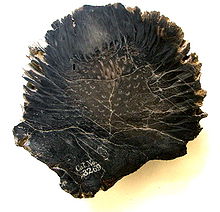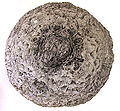- Bennettitales
-
Bennettitales
Temporal range: Triassic to Cretaceous
A Cycadeoid, showing an "inflorescence" in the top-right Scientific classification Kingdom: Plantae Division: Spermatophyta Class: Spermatopsida Order: Bennettitales † Families Cycadeoidaceae
WilliamsoniaceaeBennettitales (the cycadeoids) is an extinct order of seed plants that first appeared in the Triassic period and became extinct toward the end of the Cretaceous (i.e. they existed around 250 to 70 million years ago).[1] Some were characterized by thick trunks and pinnately compound leaves that bore a superficial resemblance to those of cycads, differing primarily in stomatal arrangement.[2]
It comprises two groups, the Cycadeoidaceae, represented by Cycadeoidea, Cycadella, and Monanthesia which had stout trunks and bisporangiate strobili (cones serving as their reproductive structures), and the Williamsoniaceae including Williamsonia, Williamsoniella, Wielandella and Ischnophyton which had slender, branching trunks and either bisporangiate or monosporangiate strobili. Bennettitales have been placed among the anthophytes, which for some time were considered to be close relatives of the flowering plants on account of their flower-like structures.[1] However, more detailed morphological studies have shown the "anthophytes" to be polyphyletic, with the Bennettitales more closely related to the cycads, ginkgo and conifers than to the angiosperms.[3] Molecular fossil evidence, however, indicates the possibility that Bennettitales and Angiosperms (along with Gigantopteridales) form a clade, based on the presence of oleanane in fossils of these groups.[4]
Gallery
-
Fossil leaf of Zamites mariposana from the Jurassic.
References
- ^ a b Speer, Brian R., 2000. Introduction to the Bennettitales http://www.ucmp.berkeley.edu/seedplants/bennettitales.html (accessed 13 Oct 2005).
- ^ Pigg, Kathleen. 2005 The Cycads, Cycadeoids (Bennettitales) and Ginkgophytes http://lsweb.la.asu.edu/kpigg/CYCAD.html (accessed 21 Sept 2007).
- ^ Crepet, W. L. (2000). "Progress in understanding angiosperm history, success, and relationships: Darwin's abominably "perplexing phenomenon"". Proceedings of the National Academy of Sciences 97 (24): 12939–41. doi:10.1073/pnas.97.24.12939. PMC 34068. PMID 11087846. http://www.pnas.org/cgi/reprint/97/24/12939.
- ^ Taylor, D. W. and Hongqi Li and Dahl, Jeremy and Fago, F. J. and Zinneker, D. and Moldowan, J. M. (2006). "Biogeochemical evidence for the presence of the angiosperm molecular fossil oleanane in Paleozoic and Mesozoic non-angiospermous fossils". Paleobiology 32 (2): 179–90. doi:10.1666/0094-8373(2006)32[179:BEFTPO]2.0.CO;2. http://paleobiol.geoscienceworld.org/cgi/content/abstract/32/2/179.
External links
- Gymnosperms
- Lecture Notes on Mesozoic Mesophytic Communities
- Weblinks to articles about the Bennettitales

This paleobotany-related article is a stub. You can help Wikipedia by expanding it.




